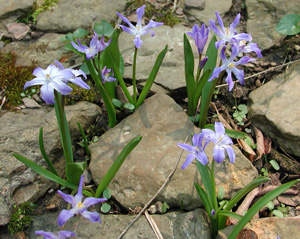Resource Library
Plant of the Week: Glory of the Snow
The University of Arkansas System Division of Agriculture does not promote, support or recommend plants featured in "Plant of the Week." Please consult your local Extension office for plants suitable for your region.
Plant of the Week
Glory of the Snow
Latin: Chinodoxa luciliae

Bulbs were one of my first garden interests and they remain intriguing all these many years later as I await the arrival of the first slender stems poking through the ground and the flowers that soon follow.
Some consider the couple weeks any particular species is in bloom a poor showing when there are 52 weeks in a year, but gardeners know better. Patiently anticipating the arrival of each species is almost as much fun as actually having them in bloom in the garden. I’m now on the prowl in my garden looking for the first signs of Glory-of-the-snow, Chionodoxa luciliae, which should appear any day now.
Chionodoxa are small bulbous perennials of the western Mediterranean region with between 6 to 8 species. It is now classified as a member of the asparagus family (subfamily Scilloideae) that was split from the overly large lily family more than a decade ago. Chionodoxa luciliae is native to western Turkey and grows to 4 inches tall with a pair of elongate, centimeter wide leaves produced from each bulb. These leaves emerge in the spring at flowering and disappear in early summer.
Three, 1-inch wide, blue to blue-purple, six-tepaled flowers with white centers are produced on a central scape 3 to 4 inches long in late winter or early spring. Because the bulbs multiply rapidly after the first season, the number of blooms produced seems to be greater than the three found on each flowering scape. A white form and a pink form are also offered in the trade. Most bulb sellers sell these plants under this name but some technical references call it C. forbesii.
The genus name translates from Greek as “chino”snow and “doxa” glory, so the common name is a translation of the technical moniker. The species epitaph luciliae honors Lucille Bossier, the wife of a Swiss botanist who must have scored big time when he named the flower after his wife. The plant was first described in 1877 and the commercial availability of Chionodoxa began about that time.
Chionodoxa is small of stature and to be appreciated in the garden must be massed along a garden path, naturalized in lawn plantings or used as a spot planting in the rock garden. If massed, plant the bulbs in the fall 2 to 3 inches apart and 3 inches deep, preferably using 50 to 100 in a grouping. If naturalized in the lawn, set the mower a bit high the first few mowing to allow the leaves to mature. Herbicide application during the time the leaves are active must be avoided.
They do best in a well-drained garden soil that receives bright light but not necessarily full sun. Avoid planting sites with heavy clay soils. In heavy shade, they disappear after a few years. A planting I made 15 years ago still persists even though it is buried beneath oak leaves each season and the slender shoots must push the leaves aside to make their presence known. If well-sited, the bulbs will produce seed and new plants will arise in unexpected places. So far this has not happened in my garden.
Glory-of-the-snow is hardy from zones 3 through 8.
By: Gerald Klingaman, retired
Retired Extension Horticulturist - Ornamentals
Extension News - February 22, 2013
The University of Arkansas System Division of Agriculture does not maintain lists of retail outlets where these plants can be purchased. Please check your local nursery or other retail outlets to ask about the availability of these plants for your growing area.